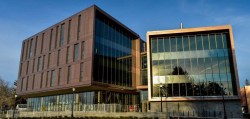Brief:
• The building houses the school’s Building and Construction Technology program, which helped develop some of the CLT used in the structure and does research on the material. The school’s architecture and landscape architecture and regional planning departments are also located in the building.
Insight:
CLT is earning strong interest across the U.S. as advocates look to the material for its durability and lower environmental impact relative to concrete and steel. Others say the engineered timber is equally as strong and resilient as traditional materials and, with the proper binding agents, can be even more fire resistant.
Other CLT proponents say the material can be more cost-effective and can reduce construction timelines significantly. At 18 stories, the University of British Columbia's new Brock Commons became the world's largest and tallest wood-framed building to rise when it topped out last September, taking just 70 days to complete the timber portion of the building on-site.
Such applications face pushback from those who question the material’s durability and fire resistance, however. In August 2016, officials in Sandy Springs, GA, blocked the construction of wood-framed buildings taller than three stories and larger than 100,000 square feet. Materials science experts say more research is needed into mass-timber’s fire resistance. While wood responds to fire by creating a protective layer of char that helps to maintain the durability of its core, how the adhesives used in engineered wood products will stand up to the heat is still being explored.
Mass timber will likely continue to gain acceptance in the coming years. At the Urban Land Institute's Washington Real Estate Trends Conference, held in Washington, DC, earlier this week, New York City–based Spiritos Properties principal Jeff Spiritos predicted that the material will be the dominant structural system for four- to 12-story buildings in the U.S. in the next five to 10 years.









